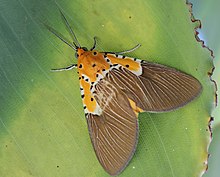Asota speciosa, the specious tiger, formerly Aganais speciosa, is a moth of the subfamily Aganainae, now regarded as part of the family Erebidae. Formerly it was regarded variously as a member of the Arctiidae, the Hypsidae, and subsequently the family Aganaidae, which was formerly regarded as a family by some authorities.[1][2] The species is widespread in sub-Saharan Africa, such as in Sierra Leone, Togo, Nigeria, Cameroon, Mozambique and South Africa.
| Specious tiger | |
|---|---|

| |
| Caterpillar of A. speciosa walking on gravel | |

| |
| Moth of A. speciosa laying on a leaf | |
| Scientific classification | |
| Domain: | Eukaryota |
| Kingdom: | Animalia |
| Phylum: | Arthropoda |
| Class: | Insecta |
| Order: | Lepidoptera |
| Superfamily: | Noctuoidea |
| Family: | Erebidae |
| Genus: | Asota |
| Species: | A. speciosa
|
| Binomial name | |
| Asota speciosa (Drury, 1773)
| |
| Synonyms | |
| |
The larvae feed on certain latex-rich plants, mainly Ficus species (fig trees), both indigenous and domestic, but also on poisonous Acokanthera species.[3] They sabotage the latex defences of their host plants by biting partway through the midrib, severing the latex vessels before proceeding to feed on the portion of the leaf blade distal to the sabotage, which is no longer supplied with latex.[4]
References
edit- ^ Zahiri, Reza; et al. (2011). "Molecular phylogenetics of Erebidae (Lepidoptera, Noctuoidea)". Systematic Entomology. 37: 102–124. doi:10.1111/j.1365-3113.2011.00607.x. S2CID 84249695.
- ^ Lafontaine, Donald; Schmidt, Christian (19 Mar 2010). "Annotated check list of the Noctuoidea (Insecta, Lepidoptera) of North America north of Mexico". ZooKeys (40): 26. doi:10.3897/zookeys.40.414.
- ^ Alan Weaving; Mike Picker; Griffiths, Charles Llewellyn (2003). Field Guide to Insects of South Africa. New Holland Publishers, Ltd. ISBN 1-86872-713-0.
- ^ COMPTON, S.G. 1987. Aganais speciosa and Danaus chrysippus (Lepidoptera) sabotage the latex defences of their host plants. Ecological Entomology 12: 115-118